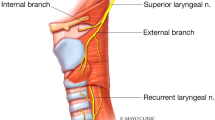Abstract
Superior laryngeal nerve (SLN) injury can cause many symptoms, the most common complaints being the inability to access the upper vocal range, difficulty projecting the voice, and vocal fatigue. Treatment with voice therapy has some limited utility in these patients. Its greatest benefit may be in preventing or treating muscle tension dysphonia, developed in compensation of the SLN injury. Numerous static and one theoretical dynamic procedure have been proposed. These procedures can help augment the cricothyroid distance. These procedures may elevate the modal pitch of the voice with varying success, with only a few patients appreciating improvement in their pitch modulation. The most promising technique described is a muscle-nerve-muscle anastomosis with a neural conduit. This allows the nerve of the healthy cricothyroid muscle to innervate the paralyzed cricothyroid and ultimately leads to simultaneous bilateral muscle contraction. Although patients undergoing this procedure have shown some benefit, it has been reported only in patients who had additional procedures for voice restoration. This results in multiple confounding variables and the true utility of the procedure is unknown. Further research is needed to help identify an optimal treatment for SLN paralysis. Due to the dearth of successful treatment options, prevention of SLN injury should be emphasized.
Access this chapter
Tax calculation will be finalised at checkout
Purchases are for personal use only
Similar content being viewed by others
References
Arnold GE. Physiology and pathology of the cricothyroid muscle. Laryngoscope. 1961;71:687–753.
Mu L, Sanders I. The human cricothyroid muscle: three muscle bellies and their innervation patterns. J Voice. 2009;23(1):21–8.
Hong KH, Ye M, Kim YM, Kevorkian KF, Kreiman J. Functional differences between the two bellies of the cricothyroid muscle. Otolaryngol Head Neck Surg. 1998;118:714–22.
Vilkman EA, Pikanen R, Suominen H. Observations on the structure and the biomechanics of the cricothyroid articulation. Acta Otolaryngol. 1987;103:117–26.
Durson G, Sataloff RT, Spiegel JR, Mandel S, Neuer RJ, Rosen DC. Superior laryngeal nerve paresis and paralysis. J Voice. 1996;10(2):206–11.
Nasseri SS, Maragos NE. Combination thyroplasty and the “Twisted Larynx:” combined type IV and type I thyroplasty for superior laryngeal nerve weakness. J Voice. 2000;14(1):104–11.
Roy N, Smith ME, Dromey C, Redd J, Neff S, Grennan D. Exploring the phonatory effects of external superior laryngeal nerve paralysis: an in vivo model. Laryngoscope. 2009;119:816–26.
Abelson TI, Tucker HM. Laryngeal findings in superior laryngeal nerve paralysis: a controversy. Otolaryngol Head Neck Surg. 1981;89:463–70.
Roy N, Barton ME, Smith ME, Dromey C, Merrill RM, Sauder C. An in vivo model of external superior laryngeal nerve paralysis: laryngoscopic findings. Laryngoscope. 2009;119:1017–32.
Sulica L. The superior laryngeal nerve: function and dysfunction. Otolaryngol Clin North Am. 2004;24:183–201.
Jansenn S, Tisell LE, Hagne I, Sanner E, Stenborg R, Svensson P. Partial superior laryngeal nerve (SLN) lesions before and after thyroid surgery. World J Surg. 1988;12:522–7.
Stemple JC, Hapner ER. Voice therapy: clinical case studies. 4th ed. San Diego: Plural Publishing; 2014.
Isshiki N, Morita H, Okamura H, Hiramoto M. Thyroplasty as a new phonosurgical technique. Acta Otolaryngol. 1974;78:451–7.
Thompson JW, Ward PH, Schwartz IR. Experimental studies for correction of superior laryngeal paralysis by fusion of the thyroid to cricoid cartilages. Otolaryngol Head Neck Surg. 1984;92:498–508.
Shaw GY, Searl JP, Hoover LA. Diagnosis and treatment of unilateral cricothyroid muscle paralysis with a modified Isshiki type 4 thyroplasty. Otolaryngol Head Neck Surg. 1995;113:679–88.
Fischer T, Pitman MJ. Optimal management of acute recurrent laryngeal nerve injury during thyroidectomy. Curr Otorhinolaryngol Rep. 2013;1:163–70.
Aviv JE, Mohr JP, Blitzer A, Thomson JE, Close LG. Restoration of laryngopharyngeal sensation by neural anastomosis. Arch Otolaryngol Head Neck Surg. 1997;123(2):154–60.
El-Kashlan HK, Carroll WR, Hogikyan ND, Chepeha DB, Kileny PR, Esclamado RM. Selective cricothyroid muscle reinnervation by muscle-nerve-muscle neurotization. Arch Otolaryngol Head Neck Surg. 2001;127:1211–5.
Author information
Authors and Affiliations
Corresponding author
Editor information
Editors and Affiliations
Rights and permissions
Copyright information
© 2016 Springer International Publishing Switzerland
About this chapter
Cite this chapter
Berzofsky, C.E., Cooper, A.L., Pitman, M.J. (2016). Postoperative Management of Superior Laryngeal Nerve Paralysis. In: Randolph, G. (eds) The Recurrent and Superior Laryngeal Nerves. Springer, Cham. https://doi.org/10.1007/978-3-319-27727-1_26
Download citation
DOI: https://doi.org/10.1007/978-3-319-27727-1_26
Published:
Publisher Name: Springer, Cham
Print ISBN: 978-3-319-27725-7
Online ISBN: 978-3-319-27727-1
eBook Packages: MedicineMedicine (R0)




